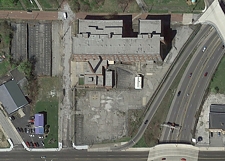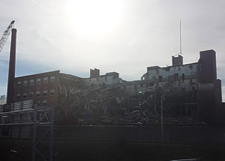|
|
|
Introduction
The Youngstown Lamp Plant was built by the National Lamp Works of General Electric to produce the then new tungsten filament lamps. Following the absorption of National into GE it was successfully operated for many more decades. During the early 1980s GE was facing considerable overcapacity in its north American lamp production facilities, as well as stiff price competition from foreign companies. The resulting restructuring led to the closure of nearly a quarter of the GE sites, with Youngstown's history coming to an end in 1985. Its production was divided between other local factories that had available capacity to absorb the Youngstown volume.
|
 General View of the Youngstown Lamp Plant of General Electric U.S.A., taken in 2014 long after closure.
General View of the Youngstown Lamp Plant of General Electric U.S.A., taken in 2014 long after closure.
|
| Address |
40 Hughes Street (formerly 617-639 Williams Street), Youngstown, Ohio 44502, USA. |
| Location |
41.0927°N, -80.6567°E. |
| Opened |
1909. |
| Closed |
1985. |
| Floorspace |
172,000 sq.ft. (15,980 m²). |
| Products |
Tungsten Vacuum squirrel cage & coiled, Tungsten Gasfilled low & high wattage, Decorative incandescent, Automotive incandescent, Christmas Decoration, Special service incandescent, Photoflash, UV mercury-tungsten glow discharge. |
Establishment under National
The factory was founded in 1909 by the National Electric Lamp Works of General Electric, to provide additional capacity for the manufacture of drawn wire tungsten filament lamps. Since it produced lamps for many of the different brand names of the various National companies, it was known simply as the Youngstown Mazda Division.
The National group's first site for the manufacture of tungsten lamps, according to the earlier squirted filament process, had been the Richland Mazda Division, located alongside the old Shelby carbon lamp factory elsewhere in Ohio. Considering the colossal investments that National made at Richland just a few years earlier, it is surprising that a second plant would have been set up so quickly - but this is perhaps indicative of the tremendous rate with which the market shifted from carbon to tungsten lamps, which may have outstripped the capacity of Richland Mazda. Alternatively it is possible that the process for the manufacture of the new drawn-wire tungsten lamps, which was perfected in the same year as the opening of Youngstown Mazda, was so different than the earlier method that it was considered best to establish a completely new factory.
Judging from examples of old National Mazda lamps which are still surviving, many of which bear the hallmarks of having been produced at the Youngstown Mazda plant, this site would appear to have produced a very wide variety of lamps, and was invariably one of the first to produce the newer types. It must therefore have been one of the most important lamp producing sites of the National Division of GE. Following the dissolution of National in 1911 and its full takeover by GE, the site became known as the Youngstown Lamp Plant of General Electric.
|
Operations under GE Lighting
In the later years, after absorption into GE, the Youngstown Lamp Plant appears to have shifted focus away from mass producing the ordinary high-volume general service lamps. It manufactured a broad variety of the slightly more specialised incandescent lamp types, such as the large high wattage and smaller low wattage general service types, along with various decorative, and certain miniature products.
A number of early Photoflash lamps also bear the factory identification code of Youngstown, however after 1943 these types are believed to have been concentrated at the nearby Bellevue Lamp Plant. Automotive lamps have also been produced at Youngstown.
Youngstown's domain apparently even extended into the bounaries of electric discharge lamps, producing a limited range of miniature mercury-tungsten glow discharge lamps for ultra-violet and ozone generating applications. The construction of such lamps is essentially the same as small incandescent products, and the location of their production within an incandescent works is therefore not surprising.
|
Closure
The 1980s marked a painful period in the history of GE's lighting operations. The company had invested heavily in the previous years to create state-of-the-art manufaturing operations, and the new equipment and manufacturing processes left it with considerable overcapacity. In parallel, the American lampmakers were facing increased competition from overseas and lamp prices were falling.
At the peak of its operations Youngstown was a sizeable operation, employing some 800 staff in 1971, but by 1983 this had dropped to around 500. General Electric's 'Lighting Leadership Plan' was unveiled to resecure the company's position in the north American lighting business, and on the 7th June 1983 it was announced that ten of the company's 42 lamp plants would close by the first quarter of 1985 - including Youngstown, Bellevue and one other in Ohio.
Around half of the manufacturing and jobs were transferred to other factories in the region - most likely to the Euclid Lamp Plant in Cleveland, and to the Ohio Lamp Plant in Warren. The factory finally closed down early in 1985.
The site lay derelict for many decades, and in a 2013 poll concerning the clean-up of the city, it topped the vote of local residents concerning the area they most wanted to see redeveloped. After nearly three decades of closure GE Lighting finally took the initiative to clean up the site, and arranged a partial demolition such that the land could be prepared for sale to new owners.
|
Photographs
|
 |
|
 |
|
 |
|
 |
| Factory Cafeteria, c.1910 |
|
Factory Lunch Room, c.1910 |
|
View from Market Street, 2014 (7) |
|
View from Hughes Street, 2014 (5) |
|
 |
|
 |
|
 |
|
 |
| View from Williams Street, 2014 (7) |
|
Aerial View, 2012 (7) |
|
Demolition of site, 2014 (5) |
|
Demolition of site, 2014 (6) |
Examples of Youngstown Lamps
|
 |
|
 |
|
 |
|
 |
|
 |
|
|
| Decorative '50-GA' |
|
Decorative 'Celeste' |
|
Silver Bowl 100W |
|
G4S11 Mercury-Ozone |
|
F5000 Blacklight DC |
|
|
| 1 |
Lamp Plant Speeds Up, Pittsburgh Post Gazette, 3rd June 1933 p.19 |
| 2 |
GE Youngstown Plant Struck, Toledo Blade, 13th April 1971 p.21 |
| 2 |
Youngstown's GE Light Bulb Plant is Closing, Toledo Blade, 11th June 1983 p.14 |
| 4 |
GE Incandescent Lamp Manuafture in Fort Wayne, Indiana, Early Incandescent Lamps website, E.J. Covington. |
| 5 |
Old GE Plant Slated for Demolition including Video Report, WKBN News, 6th March 2014. |
| 6 |
GE Plant Demolition, Defend Youngstown Website, 14th April 2014. |
| 7 |
Google Maps, 2014 |
|
|
|
|
|